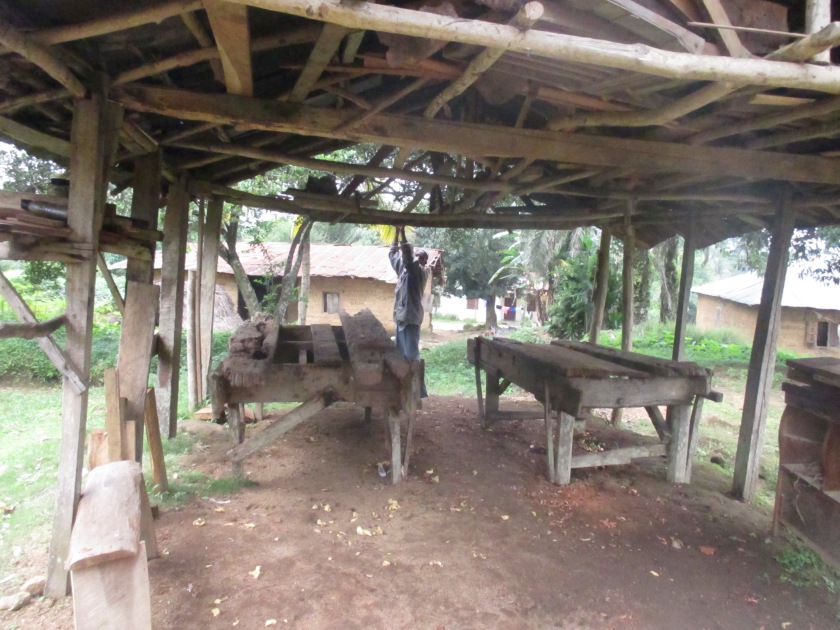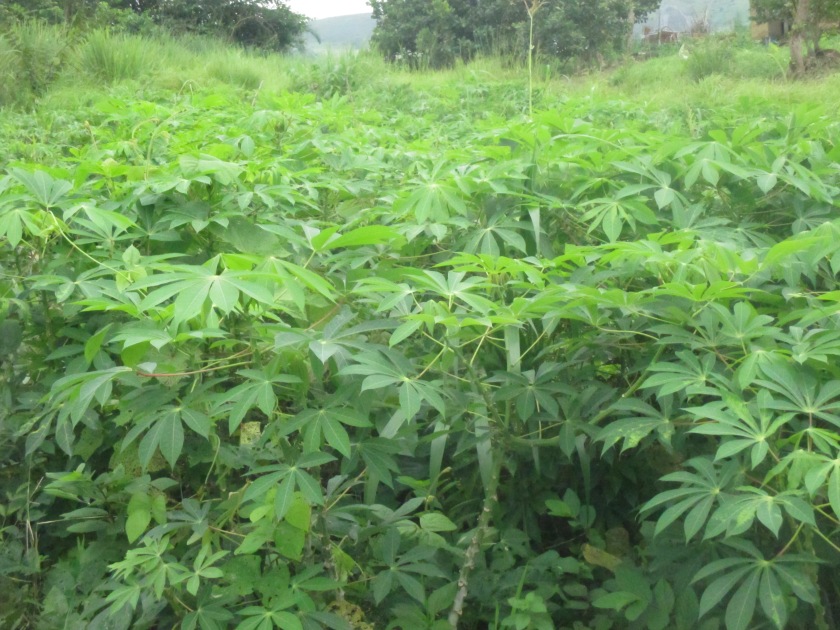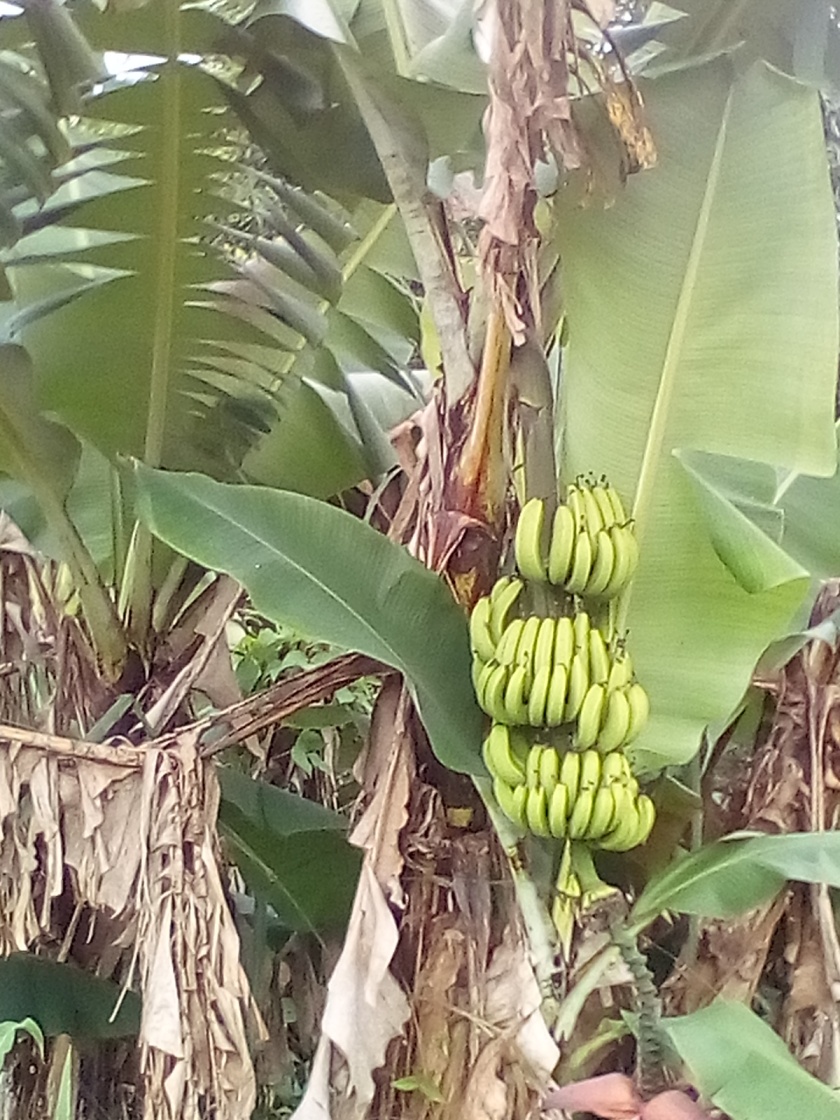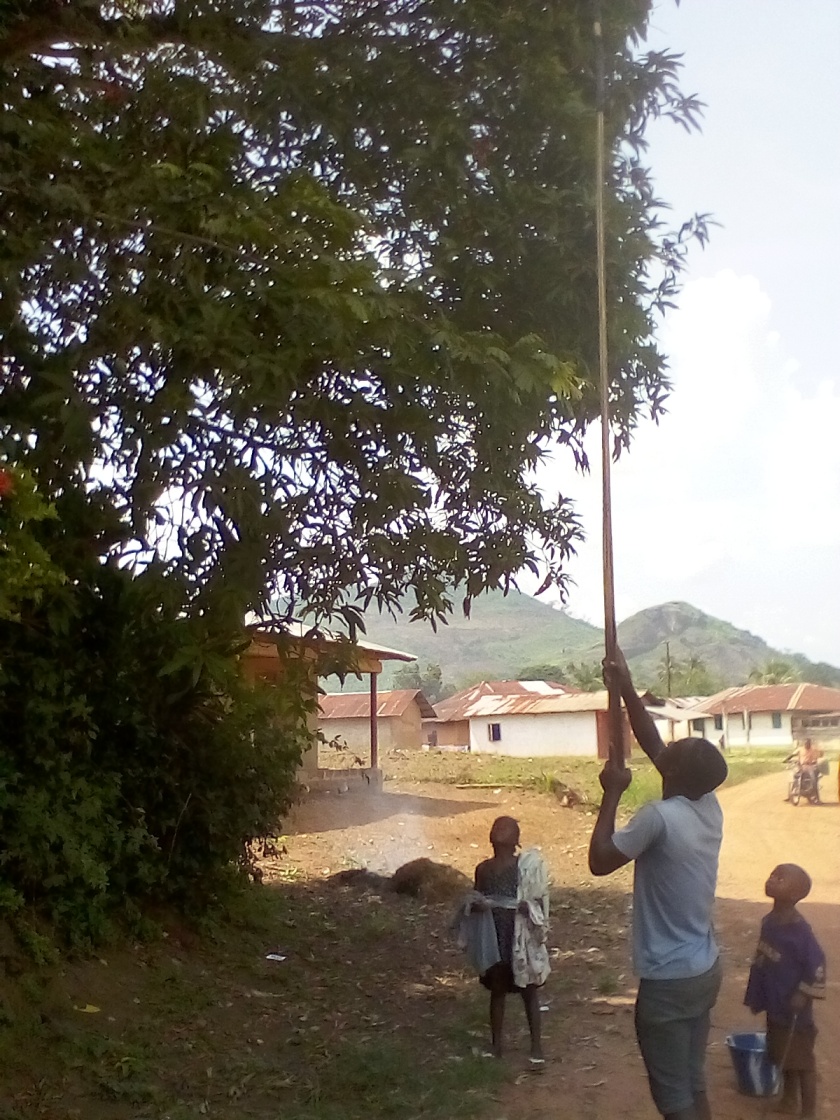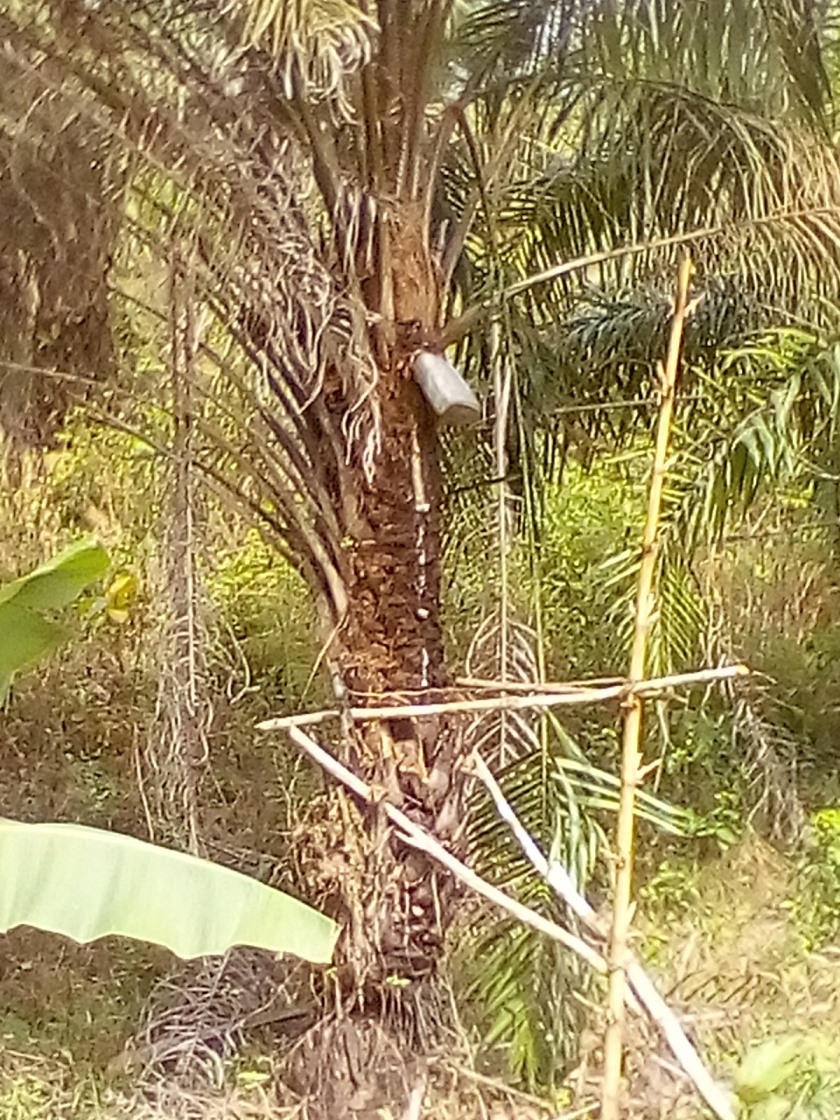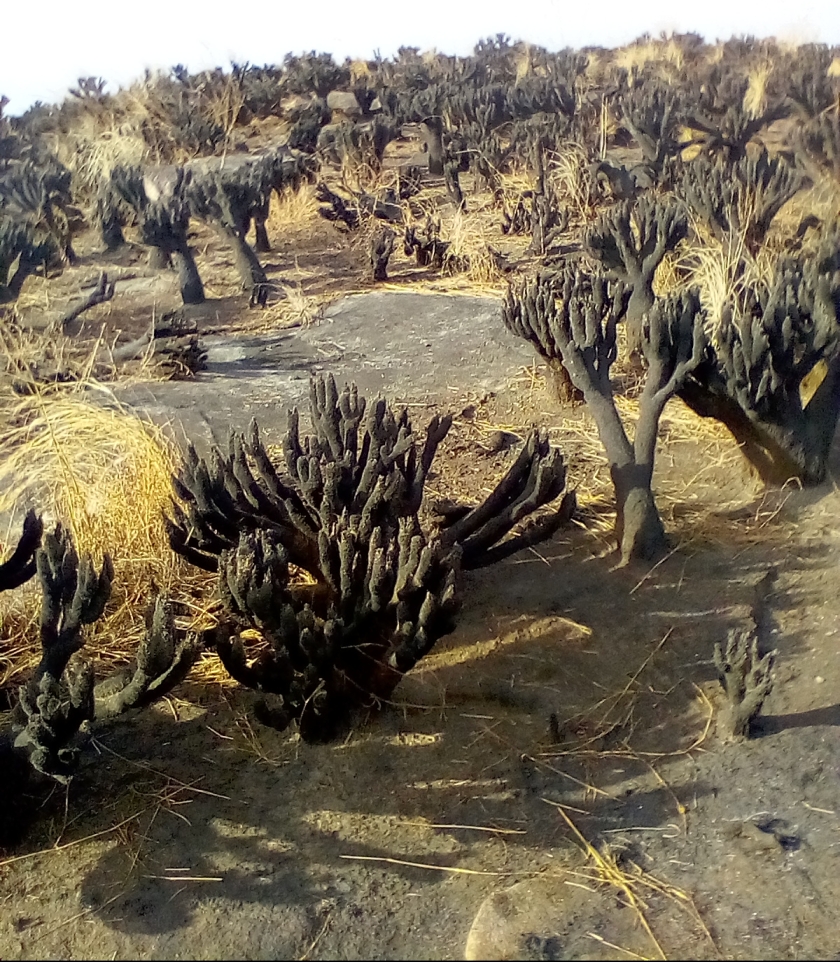The longer I live here, the more I start to see a pervasive and often irreconcilable gap in many different aspects of life in Sierra Leone between the old traditional practices and beliefs and the new modern westernized ways of doing things. In some cases there is a palpable tension between the new way and the old way, but in many others there is no tension at all really; there is a thin veneer of westernization on the surface, but other than by giving it a cursory respectful nod, locals ignore it and continue practicing the traditional way everywhere that’s beneath the surface level.
I’m typing up this post at approximately 3 o’clock in the morning, on a school night no less, after having been woken up by a parade of drummers and singers playing traditional Mende tribal music out on my street. I stubbornly refuse to go out to my porch to watch the parades when they happen at these godforsaken hours, but whenever I’m woken up by them it leads me to think about how much distance there is between the world I grew up in in America and the deep traditional parts of West African life. In the daytime, at my job as a Peace Corps volunteer, I move in the world of western-style schools, western-style hospitals, missionary churches, and foreign aid organizations; but at night, the true Sierra Leone comes out, the one that no NGO can reach, the one that I’m sometimes permitted to watch but never to join, the one that existed long before European colonizers ever got here and that will continue to exist far into the future, just beyond the line of trees or off the paved roads.
My intention in this post is not to show that the new western ways are better than the old traditional ways, or vise versa. There are some western institutions that in the western world do a lot of good, for example public formal education and modern medicine, and others that I would argue do less good (capitalism and organized religion come to mind). Similarly, there are many traditional African customs that I believe do Sierra Leone a lot of good, and others that I think the country would be better off without. My intention in this post is rather to show ways in which the forced westernization of Sierra Leone has been ineffective or caused conflicts and contradictions, and that global interactions generally with Sierra Leone have often done more harm than good. The intention of colonial and neocolonial westernization, as near as I can tell, was to recreate European society on African soil, to create a world indistinguishable from England or Germany except for the presence of palm trees and melanin. This goal is only achievable in settler colonies like America, through the genocide of preexisting native societies. The people living in Sierra Leone before European contact were not a blank slate; they could not have had a foreign culture grafted onto them because they already had a culture. This failed transformation of Sierra Leone is what I intend as the topic of this post.
Government and Economy
The national government of Sierra Leone is modeled after the West, with a president, two main political parties, a parliament, representatives from all parts of the country representing their constituents in the capital. But in the local government, no illusion of westernization is attempted. There is no mayor in my town (or if there is, I’ve never heard about it). Instead, local authority lies with the tribal chiefs, with each chiefdom having a paramount chief standing above the other chiefs. But from what I can tell, these chiefs do not hold the sort of power that a westerner might expect on seeing the word “chief”; they are not lords or kings or despots, their position usually is simply one of mediating conflicts, running town hall -type meetings, and serving as the figurehead and symbolic leader of the community when necessary. Many chiefdoms elect chiefs democratically, and in no parts of the country is the position hereditary or nepotistic. At least in the smaller rural communities, unlike in the West, there is no central authority for things like town planning, or deciding how the people will be governed. In most cases, the people govern themselves. In this way, the Sierra Leone that existed before colonization and that continues to exist beyond the influence of westernization seems much closer to a modern ideal of Anarchy (using anarchy here in the positive sense “society operated without hierarchy or central authority”, not the alternative connotation of “chaos”).
When a community is organized in this way, many of the institutions deemed essential by western standards are simply irrelevant. If conflict can be mediated through community meetings, there is no need for a police force; calling the police on a community member in rural Sierra Leone would be like an American calling the police on an immediate family member: unless it’s some sort of extreme case, there are likely many other avenues for conflict resolution that are far better than involving some sort of external authority. Yet like all other towns in Sierra Leone, my town nonetheless has a police force, no doubt established as the ultimate result of some westerner simply not understanding how a community could survive without police.
Capitalism, as well, is a western invention. And while in a region where so many are living in extreme poverty people are certainly going to invest a lot of care and worry in the idea of making money, there is still some evidence here that this was not always the case. Sierra Leone, like so many other non-European pre-colonial cultures, likely operated on a style of Gift Economy. In a gift economy, most non-personal property is communal rather than private. And while the profits of a person’s own labor are their own, people are expected to share freely with their neighbors. If I spend the day farming cassava and you spend the day hunting bushmeat, I gift you some cassava and you gift me some bushmeat. This sounds like a trade, as if I’m describing capitalism just without the use of currency, but it’s not. If one day you have a bad hunt, I’m still expected to give you cassava. And when I have a bad harvest of cassava, you’re still expected to give me meat. In this way, the community ensures it’s own communal food security, rather than each individual or family being expected to save money or resources in order to be able to make it through hard times.
The town I live in is not currently a gift economy. Goods are brought to the market in the center of town, where they are exchanged for paper currency. This is the modern westernized way, and if you ask any local they will tell you that this is how the town’s economy works. But the lingering evidence of the gift economy is still present and the residual traces can be seen. When someone cooks food in Sierra Leone, it is customary that they are fully expected to share with anyone passing by; to not do so is impolite. When someone travels out of town, even if just for a day, they are expected to bring back gifts for all their neighbors; although today this custom is mostly symbolic and done out of politeness, I suspect that it used to serve the function of redistributing excess wealth from those rich enough to travel to those stuck at home. The people of Sierra Leone (and I notice this with the children especially) excel at sharing non-personal possessions. Things like bicycles, soccer balls, books, washboards, machetes, etc. are shared so commonly and so widely that I often have no idea who the actual owner is. And if I were living here a few hundred years ago, I suspect that in many cases there would be no owner; the possessions would instead belong to the community as a whole. One thing I had always had difficulty understanding when I was new to Sierra Leone was how no one seems to really plan or save up for the future much, especially among the most rural and most poor, which to my mind were the ones most in need of good money-saving habits. My intention here is not condescension; in America as with the rest of the world, it is a well understood phenomenon that for those living in poverty, saved money inevitably gets used for unforeseen emergencies, rather than for fun splurges, whereas if small amounts of money are spent as they are acquired, they can instead be put toward enjoyment. The supposed “bad decision-making” among those in poverty in America and elsewhere happens because the depressing alternative is their saved money never getting to be used for anything the saver actually wants to save it for. However, living in Sierra Leone for a year now, I’ve been starting to think that an additional cause for the lack of contingency planning here is the pre-colonial gift economy. If people find themselves with excess money, they spend it or give it away; they expect that, as the case was before capitalism, if they later fall upon hard times their neighbors in the community will support them.
This vestigial gift economy is one of the “old ways” of Sierra Leone that I am unfortunately not able to participate in. For one thing, true participation in a gift economy would require me to allow for my wealth to be distributed until it was on the level of the people around me. While I’m not rich by American standards, I am rich by the standards of my neighbors, and I’m as-of-now not willing to give away the money I’ve saved from working in America and from my Peace Corps stipend in order to be able to immerse myself in the communal sharing. I periodically share some of my possessions (my washboard, for example) and when I travel out of town I sometimes return with small gifts for my neighbors, but I do so in a polite, symbolic way, rather than as a participant in the gift economy.
But there is another, larger obstacle to my participation in this sharing economy, beyond just my American selfishness. My whiteness and my status as an American means that from the first day I arrived in my town, people had a preconceived notion of how to interact with me economically. All of the white foreigners that rural Sierra Leone is accustomed to are people who come to town for a day, maybe a week at most, and give away copious amounts of money and food aid provided by charities, NGOs, and missionary groups. This certainly qualifies as a form of gifting, and I am by no means intending to paint foreign aid generally as a bad thing, but it does have the side-effect of preventing me from interacting with my community as economic equals. Foreign aid organizations do not participate in the sharing economy—the gifting is not mutual. They are seen as limitless suppliers of money and food, and whiteness is taken to signify this limitless one-way interaction. The danger I would face if I were to offer my money or even my cooking freely to anyone passing my house would be that I would be seen as a foreign charity, rather than as just another community member. I remember visiting a soccer field in Port Loko with a member of my host family when I had been in Sierra Leone for only a week or two. We had bought a cup of boiled peanuts to snack on while watching the soccer game, and at some point a kid I knew that lived near my host family asked me for some and I gave him a small handful without really thinking about it. Another kid nearby that I also somewhat knew saw the gift and asked if he could have some as well, and so out of fairness I also gave him a small handful. Then a mob of kids from all over the soccer field swarmed me and my host brother demanding boiled peanuts. My host brother reprimanded me and told me to not give any more away, but it was already too late; I had been fitted into the stereotype of foreign aid. Unable to disperse the mob, we ultimately had to leave the soccer field.
Medicine
One of the bigger tensions I see between the old ways and new ways of Sierra Leone is in the field of healthcare. When western organizations come in to try to remake Africa into their own image, the two biggest focuses for improvement are usually healthcare and education, and they are usually forcibly westernized, ruthlessly and heedlessly. Establishing schools in a part of the world that doesn’t already have any sort of formal education won’t generally provoke much resistance, but establishing hospitals without any acknowledgment of the sorts of medical practices that are already in place can lead to problems.
One of the assumptions that I often hear from Americans is that the struggle in healthcare here is to get people to adopt the mindset that they should take medicine when they are sick. In fact, the problem is the opposite. People in my community have been so forcefully reeducated on the topic of medicine that they no longer believe it is possible for the body to recover from illness on its own. People line up to get medicine for even the slightest headache or cold, antibiotics are abused with abandon, and when there is no appropriate prescription for whatever completely minor ailment a person has come to the hospital with (or if they simply feel like boosting their health generally), they are given pointless vitamin injections which, at best, do nothing or next to nothing other than serving as a placebo, and, at worst, can lead to abscesses, infections, or dangerous reactions. Talking with other Peace Corps volunteers (“PCVs”), a common experience that all of us seem to have had at some point is arguing with community members that it is okay for us to not take medicine for whatever minor head-cold we’ve come down with, that we’ll quickly recover naturally on our own. People here do not believe it. Oftentimes I ultimately end up lying and saying that I’m taking medicine at my house that was provided by Peace Corps, to end the argument and keep my community from worrying about me too much.
Thus in many ways, the forceful modernization of healthcare has been so complete and so careless that people have completely forgotten how they were able to live without it. Yet in other aspects of healthcare, westernization has still been unable to penetrate the deep indigenous roots. I remember a fellow PCV once summarizing the rural views on healthcare as: “if you get hurt or you get sick, you go to the western-style hospital. But if things get real bad, you go to the witch doctor.” When the vice principal at my school had wrecked his motorcycle and broken his arm, he went out to a small bush-village that’s within walking distance from my town and had it treated in the traditional way: coated in mud mixed with herbs and wrapped in a sling. One day, a local doctor from my town’s western-style hospital had been at the school and seen the arm, and commented to my vice principal that if he had gone to the hospital as opposed to the village, he could have had the bone set and put in a cast and it would heal better. I asked my vice principal about it later that day, about whether he really believed that the traditional healing was better than the hospital, and he told me that if he had went to the hospital the arm would have been amputated.
In a place where western medical practices are applied so forcefully, and often ignorantly, there is probably some kernel of truth to my vice principal’s belief. Modern medicine applied incorrectly can easily do more harm than good, whereas the traditional healing he opted for is effectively more in line with “letting the body heal on its own.” The practice of homeopathy originally gained popularity in the West in the same way: when the contemporary medical alternatives were things like blood-letting, taking substances diluted to the point of being nothing more than pure water was a successful alternative. And in the end, my vice principal’s arm did get better. But his fear that going to the hospital would have meant amputation also belies a deeper countrywide paranoia surrounding western medicine. When applied in extreme or life-threatening situations, westernized modern medicine is sometimes perceived here as being too harsh, too unnatural, too foreign to normal life. When Sierra Leone was being ravaged by the Ebola epidemic, response efforts were hindered by the widespread belief that people taken to hospitals were being euthanized to stop the spread of the disease. There’s even a popular conspiracy theory that the epidemic was engineered by the government in order to cull the country’s population. These beliefs seem extreme, but I feel like it’s only natural for there to be misunderstandings and tensions when medicine here was modernized in the careless, disconnected way that it was.
Religion
The official breakdown of religious practices in Sierra Leone lists the country as being 35% Christian, 55% Muslim, and 10% Traditional African Religion. Here, the tension I see is not so much a direct tension between foreign Abrahamic religions and indigenous religion, but more of a tension around what a religious identity really means for a person. I have to assume that the 10% figure listed above is only the people of Sierra Leone who reject Christianity and Islam outright. The majority of locals practice a surface level Christian or Islamic faith, and in every other part of their beliefs and practices maintain their traditional religion. The issue here is more a question of how one defines religion: is it the place of worship a person attends and the identity they take on, or does it extend deeper to things like superstition, worldview, cultural habits, and the way a person lives their life? For most people in Sierra Leone, it’s the former, and they are often very devout in their chosen religion, with many attending church or mosque multiple times a week. As far as formal worship practices and religious identity go, Traditional African Religion has been thoroughly stigmatized by western influence; Sierra Leoneans see those who practice traditional religion as outcasts, or more commonly, as witches whose evil practices are a cause diseases, natural disasters, and even Africa’s lack of development. I have never once met a local who self-identified as a member of Traditional African Religion.
Yet this traditional religion was never really a “Religion with a capital R” in the way that Christianity and Islam are. Instead it is a looser set of traditional customs, superstitions, and beliefs. Though I’m sure that Sierra Leoneans do not see themselves as being “unfaithful” to their chosen Religion by doing so, they nonetheless manage to practice Islam and Christianity while still staying true to their traditional religious ways. A fellow teacher at my school explained the introduction of Abrahamic religion to Sierra Leone with a level of insight that I had never expected from a local, especially one who regularly attends church. To paraphrase his explanation: “When western missionaries came to Sierra Leone and saw everyone worshiping trees and doing their pagan rituals, the missionaries must have handed the worshipers a portrait of Jesus and told them to keep doing what they were doing, but to turn around and do it while facing the portrait instead. None of the beliefs or habits actually changed.”
The factual claims of Abrahamic religions are treated with skepticism, same as with the factual claims of modern science. When learning about things such as the creation of the world, schoolchildren in Sierra Leone are given three parallel explanations: The scientific explanation (big bang theory, evolution, etc.), the religious explanation (“In the beginning God created the heaven and the earth” and so on), and the traditional African explanation. But no one’s mind is changed by these alternative explanations; traditional African beliefs are firmly established. Even among the most westernized and educated people in the capital city, beliefs such as that rivers are home to demons that purposefully drown children are still common. People know that they are supposed to learn and publicly hold to scientific and western-religious beliefs in order to appear modern and sophisticated, but the sense I get is that for many it is little more than an act.
Another aspect of pre-westernized life in Sierra Leone, that I’m choosing to lump in with religion for lack of a better understanding of it perhaps, is the secret societies. Sierra Leone is home to a men’s secret society and a women’s secret society. Between the two of them they include upwards of 90% of Sierra Leoneans (with most of the non-members being residents of the capital). Despite my town being an especially busy site for secret society activity, this is one of the “old ways” of Sierra Leone that I and other foreigners are strictly forbidden from interacting with. I am frequently told not to walk to parts of the woods where the secret societies meet; when society dancers come to town I have been told before by neighbors to stay inside and keep my door closed; and late at night I very often hear the drumming of society meetings coming from the woods surrounding town. While I don’t know much about what happens in these secret societies, the physical impacts of the secret societies are well known: tattoos, ritual scarification, and for the women’s society, female genital mutilation. Ending female genital mutilation in particular is a common target for NGOs, but these efforts seem to usually have very little success; the secret societies are very deeply rooted in Sierra Leone’s culture, and are seen by locals as off-limits for western modernization. It’s much easier for me to imagine Abrahamic religion disappearing from Sierra Leone than it is for me to imagine secret societies and traditional beliefs disappearing.
Secret societies rule life in Sierra Leone and supersede all imposed western institutions, especially in rural areas such as my town. The only local teacher at my school who I know to not be a member of the men’s society (likely due in part to his heavy involvement with a missionary church) is often challenged or flagrantly disobeyed by teenaged society member students. The foreign hierarchy separating teachers and students is powerless in the face of the secret societies’ control of traditional life here. Often these conflicts between the teacher and his students are only resolved through intervention of other teachers who are also respected members of the society.
 A “devil” being paraded around the town of Lunsar, one of the many ways in which traditional African religion is kept alive in modern Sierra Leone
A “devil” being paraded around the town of Lunsar, one of the many ways in which traditional African religion is kept alive in modern Sierra Leone
Globalization and Poverty
The picture I’ve so far been giving is that the westernization of Sierra Leone has been mostly ineffective and is restricted mainly to surface-level changes. But it would be extreme of me to go so far as to claim that westernization has hurt Sierra Leone, right? Even before contact with Europeans, wasn’t Africa always poor?
I don’t know, I wasn’t here 400 years ago. But I will say that the types of poverty I see in rural Sierra Leone are often direct or indirect results of globalization. Being poor can certainly be a natural state. But being helpless and in need of foreign aid is a learned condition.
So many of the ways in which the world interacts with Sierra Leone are ways that foster dependency. The poorest people I see in Sierra Leone are often people working jobs that didn’t exist before contact with the global market. The emaciated and completely impoverished child miners panning for diamonds in the floodplains north of my town would have been farmers 400 years ago. And even among farmers today, a large number switch to cash crops like cocoa and palm oil, things grown specifically to be exported. And certainly, these farmers are no poorer than the ones farming rice or cassava, but there’s a difference for the community: a community of rice farmers can eat what they grow, the community can be self-sufficient and independent. When global economic pressures instead lead people to pursue industries that are only good for exportation, it leaves the community food-insecure and often dependent on foreign food aid to make ends meet. And rather than being an unfortunate exception to the normal process of globalization, this fostered dependency is more like the status quo; why else would it be that the vast majority of international food aid comes in the form of donated rice and other nonperishables, rather than modern farming equipment or tools that help maximize land utilization? Teach a man to fish and he eats for a lifetime; give a man a fish and you have him by the balls.
So do the people of rural Sierra Leone not benefit at all from participation in the world economy? Most of the wealth generated by exporting diamonds and cash crops does not make it back to the rural workers who produce them. But that’s not to say that their hard work brings them nothing at all–the global economy has brought my town many mostly-unnecessary modern gadgets. But whether motorcycles, plastic grocery bags, and cell phones were a fair exchange for food security, autonomy, and dignity, is a question I leave to the reader.
People in Sierra Leone are told that their country is a shithole (they had heard it even before we elected Donald Trump), and they internalize that attitude. People in Sierra Leone are not helpless, but they are taught that they are. They learn that the best possible thing they can do to improve their country is to be helpless and desperate to appeal to the pity of western charities and thus keep the foreign aid coming. “Sierra Leone is a poor country” is not seen as a statistic or a condition that has the potential to be changed; it’s treated more as a base assumption, an axiom on which interactions with the rest of the world are based. During the 2017 solar eclipse in America, I remember being told by a neighbor of my host family in Port Loko that “Africa is too poor to have a solar eclipse.” It’s a ridiculous claim, but it’s a true indicator of the way Sierra Leoneans view their country’s poverty: African poverty is a natural, unchangeable condition, as far outside human influence as the movements of the sun and moon.
In contrast to the stereotypical Peace Corps ethos, I am not optimistic about the future. The examples of development that people are able to point to as causes for optimism are almost always external in origin. If it’s not a project funded by the EU or the Chinese government, it’s something inspired and/or directed by western ideals of modernization. These projects are not sustainable; when the NGOs leave, they fall apart. But this is not a problem for a foreign aid paradigm built around fostered dependency. Interactions with foreign governments can even take on a tragic and somewhat predatory-seeming character, such as with the way that the Chinese government has bought fishing rights for Sierra Leone’s coastal waters, leading to an overfishing crisis that will likely result in food shortages for local populations in the coming decades. I’m reminded of Native American tribes that sold their land to Europeans in exchange for trinkets, out of a misunderstanding of what someone could possibly mean by “owning” land. Land is communal, how could someone own it? Similarly, how could someone buy out all the fish in the ocean? Won’t there always be more fish?
Even ignoring negative interactions with foreign governments, the world of the future is quickly becoming a more and more hostile place. Billboards along the highways of Sierra Leone tell me to STOP DEFORESTATION, and that CLIMATE CHANGE IS REAL. Yet I can’t in good conscience put the burden of mitigating environmental impact on the farmer who clear-cuts a patch of woods in order to grow food to support his family. The true blame for the approaching environmental disaster lies with the developed world, and to a lesser extent with the developing world, but not with the chronically undeveloped world of rural Sierra Leone. The blame lies with the capitalist mentality that global warming will only be taken seriously once it becomes profitable to do so; and by then it will be much too late. For pretty much as long as I’ve been alive, science news articles have said things like “Global warming can be stopped, but only if we reduce carbon emissions by [some amount] within the next [some number of] years.” This is never going to happen. The developed and developing worlds have reaffirmed time and again that they will continue to consume fossil fuels until the last droplet of economic growth can be squeezed from them, carbon-footprint-be-damned. It is too late for us to stop climate change. And tragically, it will be innocent Sierra Leoneans, along with the rest of the global south, who will be the first to bear the consequences of First World avarice.
As global warming, overfishing, and a growing population lead to food and fresh water shortages later this century, many current forms of agriculture in the Third World will become untenable, governments will collapse, wars will break out, and there will likely be a massive die-off among the world’s poorest. Rather than rising to the occasion, foreign aid will likely be forced to retreat as things worsen in the wake of global climate catastrophe. Places like my town will once again be beyond the reach of western influence; they will perhaps return to many of the old ways that never really died out in the first place, even as desertification spreads across sub-Saharan Africa and makes survival all-the-more challenging. Who knows, maybe in our absence, rural Sierra Leoneans in a dying world will be able to carve out a better sort of existence than what the developed world was able to provide them with.
Postscript
I waited over a year to write this blog post, but by no means am I an expert on Sierra Leone. The longer I live here, the more things I realize I still don’t understand. If readers feel that I’ve made a mistake in any of my above analyses, I probably have. As my perceptions of Sierra Leone change over the coming year, I will maybe return to some of the ideas in this post with follow-ups, comments, or corrections.
If you liked this post, you can thank the Mende musicians that woke me up with this song in the middle of the night to write it:
https://soundcloud.com/t0bor/mende-song/s-ZrG2j




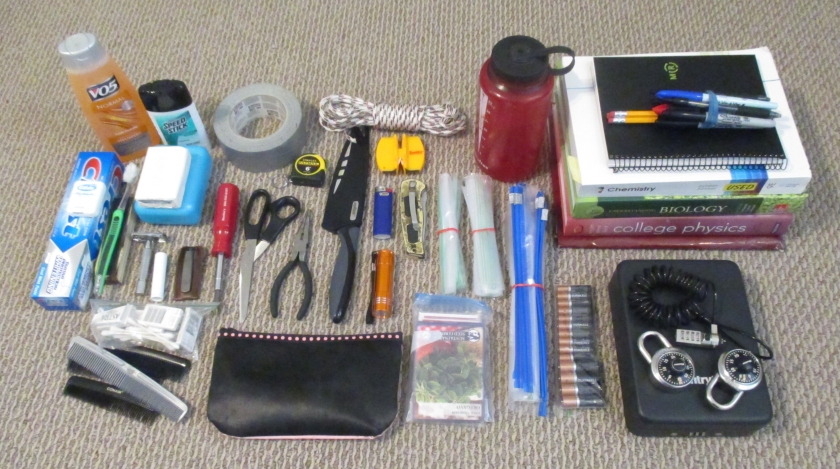
















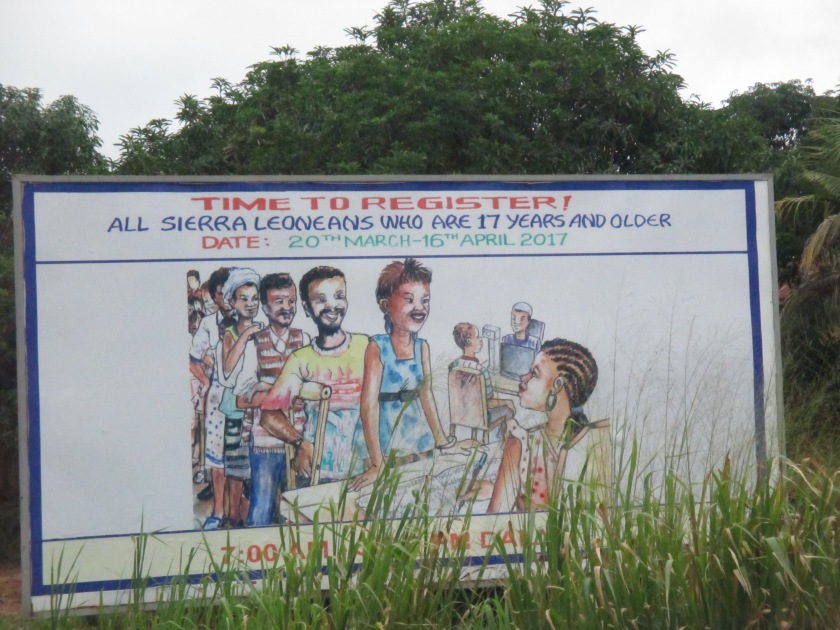






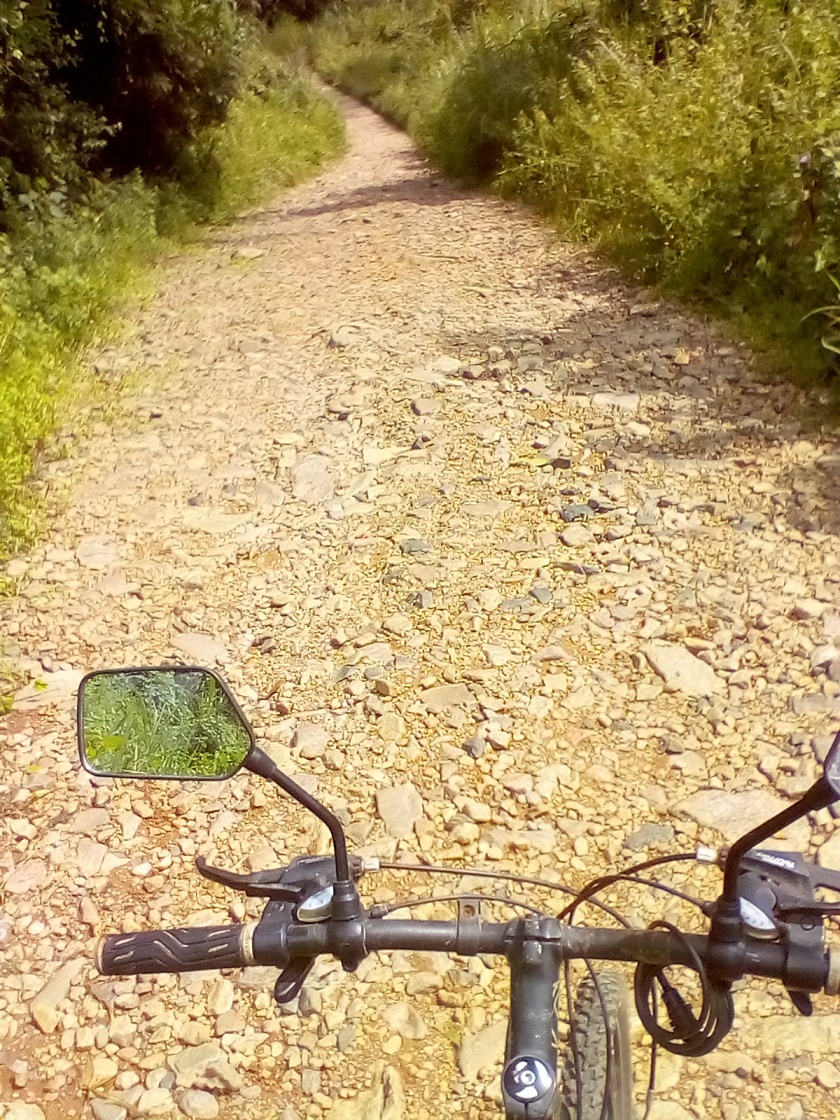







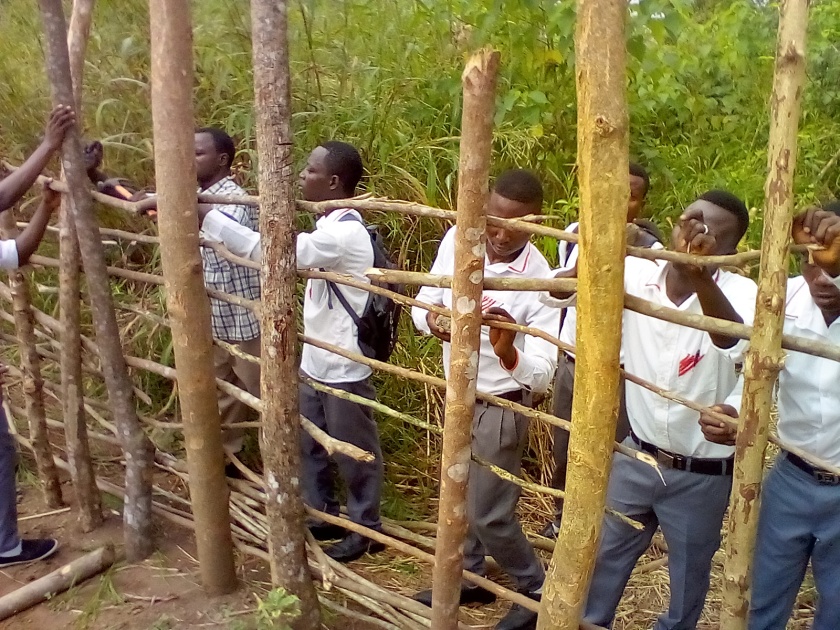
 A “devil” being paraded around the town of Lunsar, one of the many ways in which traditional African religion is kept alive in modern Sierra Leone
A “devil” being paraded around the town of Lunsar, one of the many ways in which traditional African religion is kept alive in modern Sierra Leone











